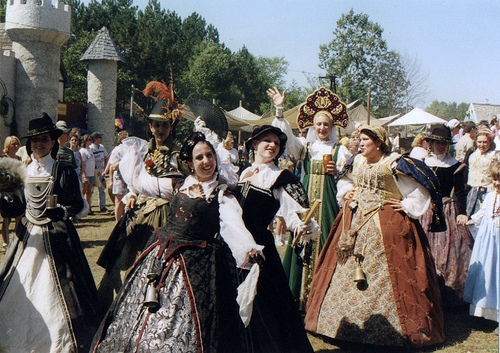Tudor era has gained a huge significance in the history of England. This was the era of flamboyance. The popular renaissance age also took place during that period, which awakened the cultural instinct of the people. The medieval clothing of that era is a perfect example of this cultural instinct. Besides, the Tudor dynasty established its kingdom, which ruled over more than a century.
Six monarchs were witnessed by the English people during that era, from Henry VII to Elizabeth I. The dynasty comprised of both positive and negative traits. Henry VII, Henry VIII, Edward VI, Mary Jane Gray Mary I and Elizabeth I were the monarchs of this dynasty.
Henry VII: Henry VII was the first king from this dynasty, who was born in Pembroke. He defeated Richard III at the battle of Bosworth Field in 1485 and claimed the throne. He restored the stability in England and ruled for 24 years. The policy of Henry VII was to maintain peace and economic prosperity. He married Elizabeth of York who was the niece of Richard III.
Henry VIII: Henry VIII was the son of Henry VII, who was declared king after the death of his father in 1509. In the early years, Henry was known for his friendliness. He was a companion more than a king. He was generous in his affection and gifts. But, in the later years people started describing the king for his fatigue and cruelty. Henry broke his alliance with Rome and declared himself as the head of Church of England. He made an alliance with Protestant German states by marrying the daughter of a Protestant German Duke. He married six girls in distinct periods. Mary I, Elizabeth I and Edward VI were his three children of Henry VIII, who were born through different wives. Edward VI was the youngest, but was declared as his first heir, because he was the only male among them. Mary I and Elizabeth I were given place after him in the line of succession.
Edward VI: Henry VIII died in 1547, when Edward was only 9-years old. He was declared king in this small age. Surprisingly, Edward would take an interest in religious matters. He was a believer of Protestantism, and “Book of Common Prayer” was published during his reign. But, he found his succession problematic. His elder sister Mary I was a devout catholic and Edward was afraid that she would reverse the protestant reforms made by him and his father. So, he removed Mary and Elizabeth from the line of succession. Elizabeth was a protestant, but it was necessary to remove both of them to expel one as per the law. He changed his father’s will and gave the succession to his cousin sister Lady Jane Gray. Edward died in the small age of 15, in the year in 1553.
Lady Jane Gray: Lady Jane Gray was a proclaimed queen after Edward, but her support was lost in 9 days.
Mary I: Mary I was the next monarch from the Tudor dynasty, but she proved to be a troubled queen. She used all means to restore the catholic faith, and burnt many innocent Protestants in stake. Because of this, she is dubbed as ‘Bloody Mary’. She married Philip of Spain to produce a catholic heir, but could not be successful. Finally, she had to declare her sister Elizabeth as her successor. Mary died in 1558, in the age of 42.
Elizabeth I: Elizabeth I was the most famous monarchs of Tudor dynasty. She never let anyone challenge her authority as a monarch. She also faced the pressures to marry, which she never accepted. She was also fond of fashion. During her era, flamboyant renaissance shirt were gaining popularity. Her clothes beaded with ornaments had the special allure. She died in 1558, which was the end of Tudor era.





 Renaissance was the age when set ideals of society in Europe were broken and new ways of thinking emerged and supported. This period has given rise to inspiration for the modern world, for people who want to make a change in the traditional ideas and lifestyles. This is also reflected in the degree of freedom the Renaissance society had in its dress, the range of colours, outfits and patterns of clothing.
Renaissance was the age when set ideals of society in Europe were broken and new ways of thinking emerged and supported. This period has given rise to inspiration for the modern world, for people who want to make a change in the traditional ideas and lifestyles. This is also reflected in the degree of freedom the Renaissance society had in its dress, the range of colours, outfits and patterns of clothing. 
 1490s is the time when costumes began to acquire a Renaissance look of extravagance in Europe. Even within this framework, different parts of Europe followed different styles. England followed a more mediaeval look in Renaissance dresses than other parts of Europe. Flowing lines, puffed long sleeves, head-dresses, velvet and silk lined with brocade and laces became the norm in aristocratic
1490s is the time when costumes began to acquire a Renaissance look of extravagance in Europe. Even within this framework, different parts of Europe followed different styles. England followed a more mediaeval look in Renaissance dresses than other parts of Europe. Flowing lines, puffed long sleeves, head-dresses, velvet and silk lined with brocade and laces became the norm in aristocratic 